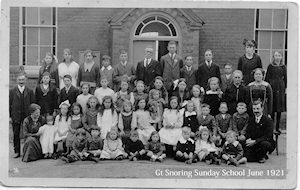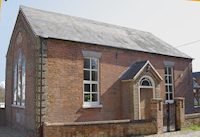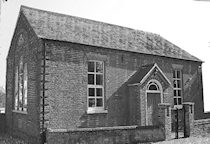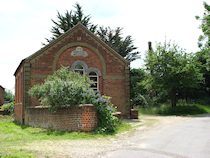Come with me now to the Primitive Methodist Chapel, at the top of the Loke, next to Shackcloth’s yard.
There is silence around the traction engines because it is Sunday morning, and forty or so youngsters, from toddlers to teenagers, are there for Sunday School, in various small classes dotted around the pews. In charge is the patriarchal, full bearded figure of John White. He will tell you he had no chance of schooling himself, but worked on the farm from a tender age, and that his wife taught him to read after they married.
As a local preacher his reading concentrates on one essential book. “ You’ve allus got to hey a sarmon in yar pocket for when the preacher don’t tarn up ” he says. So when the Sunday School outing on the charabanc to Hunstanton came to an end, someone asked, “ Have you had a nice day, Mr. White ?” “ Oh, wonderful ”, he said, “ I’ve set in that there shelter and read my New Testament all afternoon ”.
Other older leaders know their limitations as ‘scholars’. One tells his class as they read aloud, “ Do you come to a word what you don’t know, don’t you ask me. Just say wheel-barrer and carry on ”. But now it is Sunday morning, and they will be telling the children with simplicity and sincerity what they do know by experience - the faith which they hold, and which holds them.
In the raised seats beside the pulpit, Sam Howlett has the older boys. He’s probably telling them again his favourite story of Daniel in the lions’ den. Two of those lads, John and Alf Jackson, are destined to become Salvation Army officers - John reaching the rank of Brigadier.
Below the doorway Mrs. Susan Collins has her class. Clothed from head to toe in faded funereal black, looking thin and frail, with wisps of white hair. When she is asked to speak to the whole company, out comes her favourite text: “Greater love hath no man than this, that a man lay down his life for his friends. Ye are my friends, if ye do whatsoever I command you .”(John 15:13-14) KJV
Across the aisle the older girls are with the Superintendent’s brother, Tom White, the farm steward who pays most men in the village their wages. Tall and spare, with side-whiskers, we all recognise a kindly, gentle man with a ready smile. Earnest like the others, he uses a strange but impressive word for children, “ It behoves us all to turn to Jesus while we may.”
There are younger folk making a start at teaching. Alongside all this, children are learning from one another, and these lesser truths prove much more memorable. Opening the hymnbook, they show you the heading “CONTENTS”. Then they tell you what the letters stand for - Cows Ought Not To Eat Nasty Turnip Stalks. And PREFACE - Pigs Really Enjoy Fresh Acorn Collected Early.
The highlight of the year is the Anniversary, the first Sunday in June,when that Jolly man Maurice Grief comes from Repps to lead all the services and the children sing their songs and say their ‘pieces’ as best they can remember them, and the place is packed out. On the Monday morning, to reach an even wider audience, and so pick up a few more pennies, we go on a farm waggon to outlying parts of the village and our pieces get an encore.
Then in the afternoon there are sausage rolls and fish-paste sandwiches on the cricket pasture. A weekend to anticipate, and to remember.
Local Preachers
As for the afternoon and evening services, we are served by a variety of local preachers - mostly men but a few women - who walk or cycle many miles to fulfil their engagements. We get to know their habits and eccentricities. Some will bring an assistant - a sort of apprentice - to read the lessons. One tells how his eye was blinded when breaking flints for road making. Mr. Bennell is inseparable from his little black notebook.
Horace Webdale from Wells railway station is popular, a humorous man who is bound to raise a laugh. Herbert Mace, the Hindringham baker, comes with his horse and trade cart. We watch to see if it is true that he puts an acid drop in his mouth while we sing the hymns, but puts it down on the seat while he’s preaching. Look where it has taken off the varnish!
Some have an arresting style of opening, like Charlie Gidney the Binham blacksmith. “ I’m going to start like my dear old father used to do. He’d say, This here Chapel is like a saucepan. You people out there are like the dumplin’s, and I’m the spune to star yer up with !’”
From time to time we get the Minister from Wells, the Revd. Tom Featherstone. He is long and lean, and travels the whole circuit on a tall pushbike. He can tell a vivid story to children. One boy at least has not forgotten listening spellbound to the tale of Mr. and Mrs. Stickers, proud parents of their son William. They were on a train, in the same carriage as an old gentleman who eventually fell asleep. Fidgeting William happened to notice that a bright half crown had slipped out of the old man’s pocket.
Despite the battle that raged in his conscience William casually covered it with his hand and, when none was looking, transferred it to his own Jacket. Though he felt so guilty, he kept reminding himself that no one knew what he had done. But when they got out at the station, there for everyone to see, in the largest letters he had ever seen, it said “ Bill Stickers will be prosecuted ”. Talk about your sins finding you out!
In winter we depend on the hanging paraffin lamps and the solitary tortoise stove (Fred Colman always sits by it to keep it company!) and the chapel has a distinctive atmosphere of its own - a bit conducive to dozing in the less inspiring sermons. But the singing will rouse you. There is no choir, nor any need of one. Mrs. Harrison does it all. She pumps with her feet, plays with her fingers, and leads the singing in a strong, deep voice that people can hear and follow all over the chapel.
Oh, just one little word of advice. Get up and out fairly sharpish when the afternoon service ends, or you might find yourself last and have to ask the preacher home to tea!
This photograph of the Chapel Sunday School was taken in June 1921 when Fred Collins and his wife (far right) were leaving for Heacham. Hastily arranged, some adult leaders were at work and unable to pose. William ‘Carlo’ Southgate (MY GRANDFATHER) - is on the far left. The group was photographed twice. At the first take, little Alfie Jackson (front far left), when he saw the photographer put the black cloth over his head, took fright and ran away!

![]() See the original text and photos of this account HERE
See the original text and photos of this account HERE









